Analysis of Business Structures: Commercial and Corporation Law
VerifiedAdded on 2023/06/11
|11
|3157
|282
Report
AI Summary
This assignment provides a comprehensive analysis of various business structures available in Australia, including sole proprietorships, partnerships, trusts, and corporations, under Commercial and Corporation Law. It includes a letter advising John Smith on selecting a suitable business structure, recommending a limited liability partnership due to its balance of flexibility and liability protection. The assignment further explores the duties of company directors as outlined in the Corporations Act 2001 (Cth), emphasizing the importance of acting with care, diligence, good faith, and avoiding misuse of position or information. Key director duties such as the duty of care, duty to act in good faith, and the prohibition of using their position or information for personal gain are discussed with reference to relevant case law. This detailed solution is available for review and study on Desklib, a platform offering a wide range of academic resources for students.
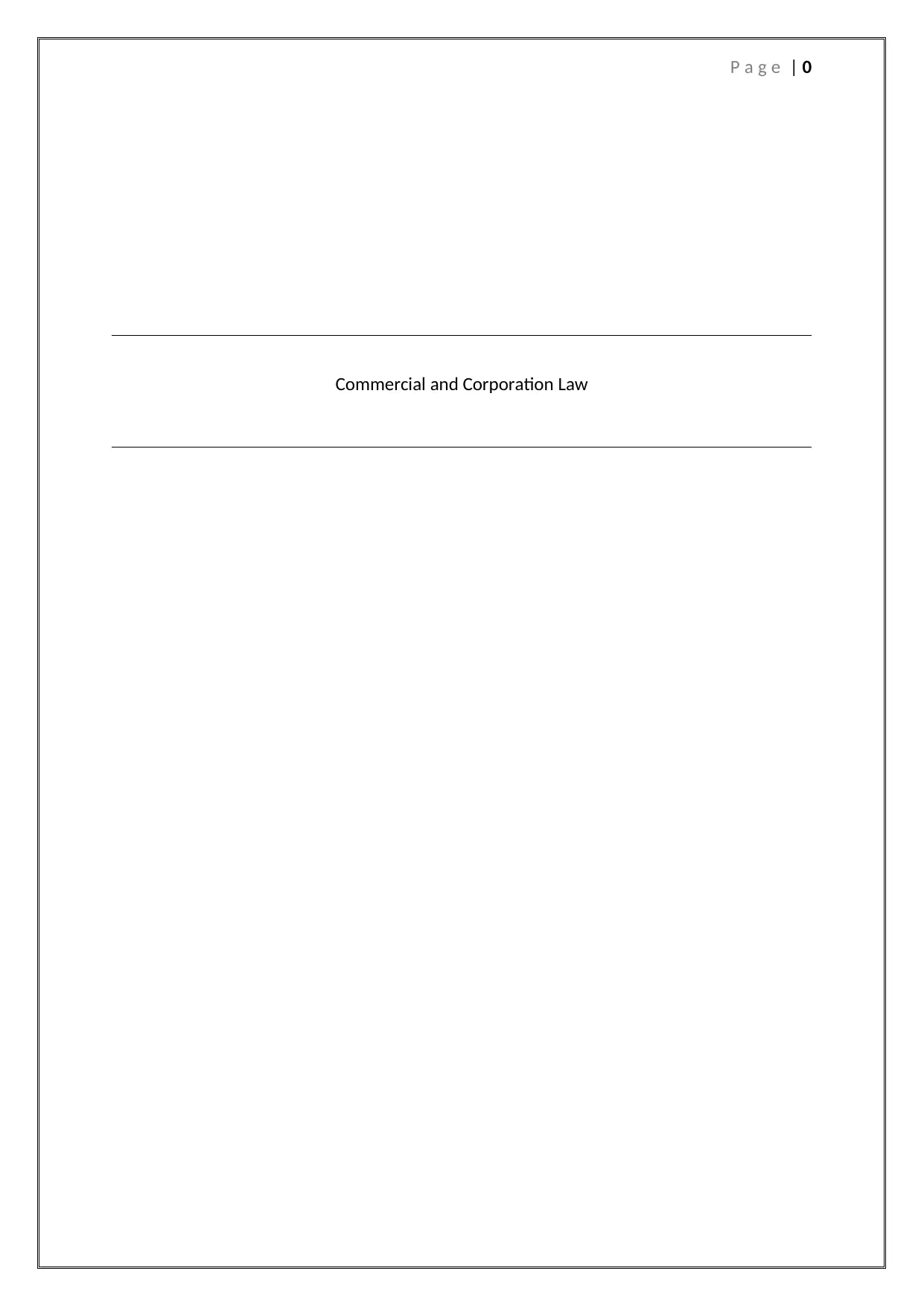
P a g e | 0
Commercial and Corporation Law
Commercial and Corporation Law
Paraphrase This Document
Need a fresh take? Get an instant paraphrase of this document with our AI Paraphraser
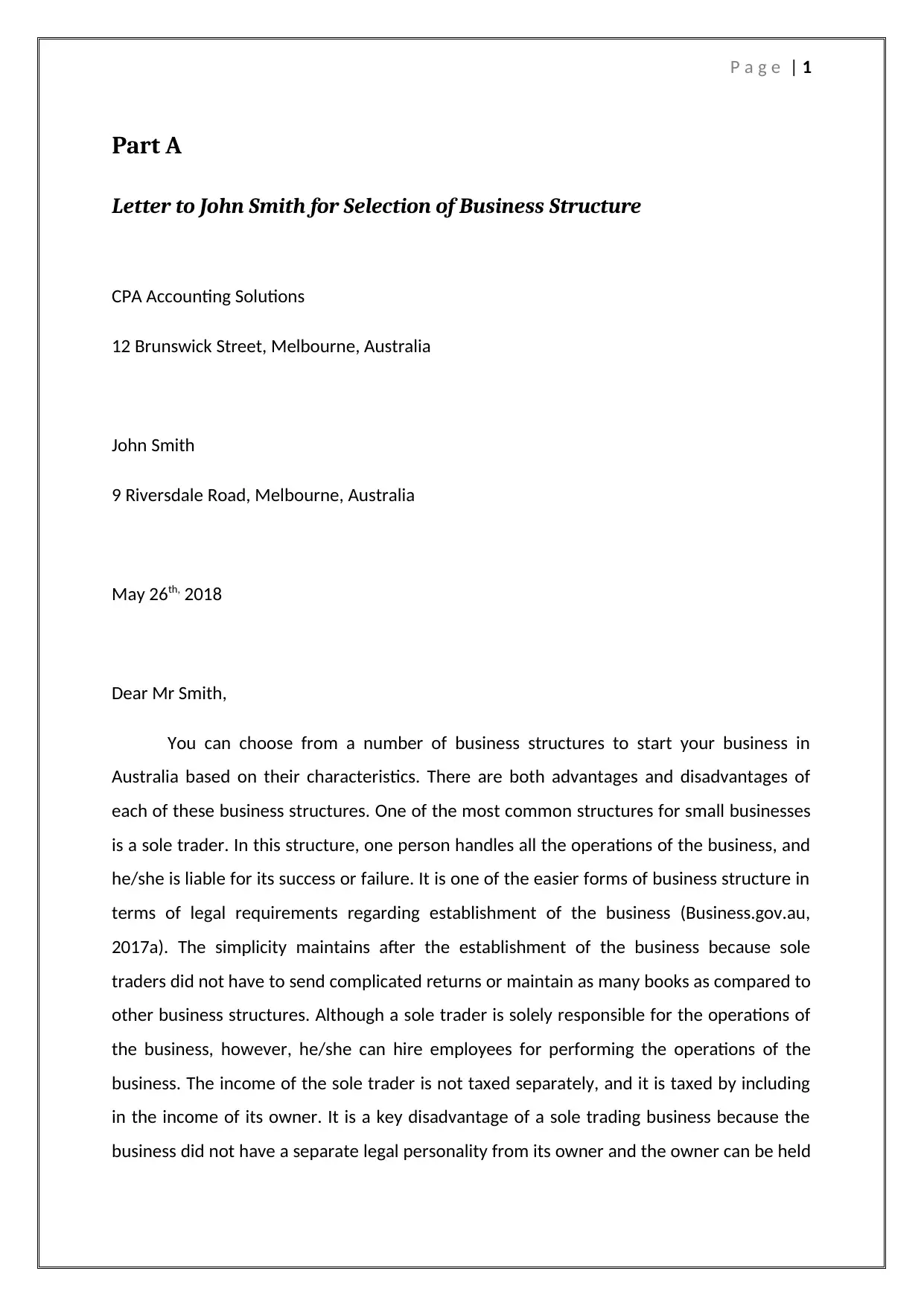
P a g e | 1
Part A
Letter to John Smith for Selection of Business Structure
CPA Accounting Solutions
12 Brunswick Street, Melbourne, Australia
John Smith
9 Riversdale Road, Melbourne, Australia
May 26th, 2018
Dear Mr Smith,
You can choose from a number of business structures to start your business in
Australia based on their characteristics. There are both advantages and disadvantages of
each of these business structures. One of the most common structures for small businesses
is a sole trader. In this structure, one person handles all the operations of the business, and
he/she is liable for its success or failure. It is one of the easier forms of business structure in
terms of legal requirements regarding establishment of the business (Business.gov.au,
2017a). The simplicity maintains after the establishment of the business because sole
traders did not have to send complicated returns or maintain as many books as compared to
other business structures. Although a sole trader is solely responsible for the operations of
the business, however, he/she can hire employees for performing the operations of the
business. The income of the sole trader is not taxed separately, and it is taxed by including
in the income of its owner. It is a key disadvantage of a sole trading business because the
business did not have a separate legal personality from its owner and the owner can be held
Part A
Letter to John Smith for Selection of Business Structure
CPA Accounting Solutions
12 Brunswick Street, Melbourne, Australia
John Smith
9 Riversdale Road, Melbourne, Australia
May 26th, 2018
Dear Mr Smith,
You can choose from a number of business structures to start your business in
Australia based on their characteristics. There are both advantages and disadvantages of
each of these business structures. One of the most common structures for small businesses
is a sole trader. In this structure, one person handles all the operations of the business, and
he/she is liable for its success or failure. It is one of the easier forms of business structure in
terms of legal requirements regarding establishment of the business (Business.gov.au,
2017a). The simplicity maintains after the establishment of the business because sole
traders did not have to send complicated returns or maintain as many books as compared to
other business structures. Although a sole trader is solely responsible for the operations of
the business, however, he/she can hire employees for performing the operations of the
business. The income of the sole trader is not taxed separately, and it is taxed by including
in the income of its owner. It is a key disadvantage of a sole trading business because the
business did not have a separate legal personality from its owner and the owner can be held

P a g e | 2
liable for its debts (ASIC, 2018). The owner himself raises the capital in the business and this
structure is suitable for small businesses.
In case people wanted to start and operate a business with other individuals, then a
partnership can be formed. It is governed by the Partnership Act 1891 (SA), and its definition
is given under section 1 (Legislation, 2018a). It is referred to a relationship between two or
more people who decided to enter into an agreement to carry out business in common with
a view of profit; these are the key elements of a partnership. Firstly, the relationship
between parties is a key element of a contract which must be established between two or
more people (Joyce v Morrissey (1998) TLR 707). The objective of a partnership is to carry
out business as given in Mann v D’Arcy (1968) 1 All ER 172 (Duncan, 2012). Generally, the
liability of partners is unlimited which means that its liabilities bind them and the creditors
can hold them liable for the debts of the partnership as given under section 9. The partners
must operate a business in common; if the partners are not running a business in common,
then it cannot be constituted as a partnership as given in the judgment of Saywell v Pope
(1979) STC 824 (Ch) case.
The purpose of the partnership must be to generate profits irrespective of the fact
whether the partners have realised such profits or not (Jennings v Baddeley (1856) 3 K&J 78)
(Mugambwa, Amankwah & Haynes, 2007). Although liability of partners is unlimited,
however, under section 48 (1) two or more individuals can form a limited liability in which
their liability is limited to the amount specified in their partnership agreement. In case of
limited liability partnership, registration of the business is a mandatory requirement rather
than optional as given under section 54 (1). People can also establish trust in order to
operate their business in Australia, however, the formation of a trust is relatively more
complex than compared to other business structures. In a trust, the trustee holds the
property for another person who is referred as beneficiary and the property is held for the
benefit of the beneficiary. A trustee is responsible for the actions taken by him while holding
the property for the beneficiary. While forming a trust, it is mandatory that a trust deed is
signed between the trustee and the beneficiary that provides the rights and liabilities of the
trustee and beneficiary (Business.gov.au, 2017b).
liable for its debts (ASIC, 2018). The owner himself raises the capital in the business and this
structure is suitable for small businesses.
In case people wanted to start and operate a business with other individuals, then a
partnership can be formed. It is governed by the Partnership Act 1891 (SA), and its definition
is given under section 1 (Legislation, 2018a). It is referred to a relationship between two or
more people who decided to enter into an agreement to carry out business in common with
a view of profit; these are the key elements of a partnership. Firstly, the relationship
between parties is a key element of a contract which must be established between two or
more people (Joyce v Morrissey (1998) TLR 707). The objective of a partnership is to carry
out business as given in Mann v D’Arcy (1968) 1 All ER 172 (Duncan, 2012). Generally, the
liability of partners is unlimited which means that its liabilities bind them and the creditors
can hold them liable for the debts of the partnership as given under section 9. The partners
must operate a business in common; if the partners are not running a business in common,
then it cannot be constituted as a partnership as given in the judgment of Saywell v Pope
(1979) STC 824 (Ch) case.
The purpose of the partnership must be to generate profits irrespective of the fact
whether the partners have realised such profits or not (Jennings v Baddeley (1856) 3 K&J 78)
(Mugambwa, Amankwah & Haynes, 2007). Although liability of partners is unlimited,
however, under section 48 (1) two or more individuals can form a limited liability in which
their liability is limited to the amount specified in their partnership agreement. In case of
limited liability partnership, registration of the business is a mandatory requirement rather
than optional as given under section 54 (1). People can also establish trust in order to
operate their business in Australia, however, the formation of a trust is relatively more
complex than compared to other business structures. In a trust, the trustee holds the
property for another person who is referred as beneficiary and the property is held for the
benefit of the beneficiary. A trustee is responsible for the actions taken by him while holding
the property for the beneficiary. While forming a trust, it is mandatory that a trust deed is
signed between the trustee and the beneficiary that provides the rights and liabilities of the
trustee and beneficiary (Business.gov.au, 2017b).
⊘ This is a preview!⊘
Do you want full access?
Subscribe today to unlock all pages.

Trusted by 1+ million students worldwide

P a g e | 3
Lastly, the most common and popular business structure in Australia is a company
which is divided into two types which include the public and proprietary company. The
formation and regulations of a company are governed by the Corporations Act 2001 (Cth).
Unlike other business structure, a corporation has a separate personality from its owners as
given in Salomon v Salomon & Co Ltd (1897) AC 22 case (Whincop, Keyes & Posner, 2018). In
this case, the court provided that the members or shareholders of a corporation cannot be
held liable for its debts and the company has its separate legal personality. A separate
personality means that after its incorporation, the corporation acquires similar rights as a
human being based on which it can sue or get sued by third parties, and it can hold property
under its name. While suffering from a financial injury, a company has the right to sue the
breaching party rather than its shareholders as given in Foss v Harbottle (1843) 67 ER 189
case (Idensohn, 2012).
The capital of a company is divided into small parts called shares, and the
corporation can raise capital by issuing its shares. A public company can issue share to the
public, and there is no maximum limit of shareholders whereas a proprietary corporation
issues share to friends and family and it cannot have over 50 shareholders as given under
section 113 (1) (Austlii, 2018). A corporation can run its operations with a minimum of one
member as given under section 114. Another advantage of a corporation is perpetual
succession which means that it did not get affected if one of its members leave the company
or died. In case of other business structures such as a sole trader, partnership and trust, the
business terminated after the death of its members. However, a company has a separate
personality, and it is not affected by the death of its members. Along with many benefits,
there are few disadvantages of a corporation as well such as complex formation, compliance
with a number of provisions, disclosure requirements, lack of privacy regarding financial
records, and others (ASIC, 2018).
Finally, in order to select a business structure for your business Mr Smith, a
partnership is more suitable than compared to others. Currently, you are just starting in the
fashion industry, and the size of your business is relatively small. Thus, by selection a
partnership business structure you will have to face fewer legal regulations than compared
to a company or a trust while at the same time you will have more rights than compared to
a sole trader. You can partner with local businesses which are operating in the men’s
Lastly, the most common and popular business structure in Australia is a company
which is divided into two types which include the public and proprietary company. The
formation and regulations of a company are governed by the Corporations Act 2001 (Cth).
Unlike other business structure, a corporation has a separate personality from its owners as
given in Salomon v Salomon & Co Ltd (1897) AC 22 case (Whincop, Keyes & Posner, 2018). In
this case, the court provided that the members or shareholders of a corporation cannot be
held liable for its debts and the company has its separate legal personality. A separate
personality means that after its incorporation, the corporation acquires similar rights as a
human being based on which it can sue or get sued by third parties, and it can hold property
under its name. While suffering from a financial injury, a company has the right to sue the
breaching party rather than its shareholders as given in Foss v Harbottle (1843) 67 ER 189
case (Idensohn, 2012).
The capital of a company is divided into small parts called shares, and the
corporation can raise capital by issuing its shares. A public company can issue share to the
public, and there is no maximum limit of shareholders whereas a proprietary corporation
issues share to friends and family and it cannot have over 50 shareholders as given under
section 113 (1) (Austlii, 2018). A corporation can run its operations with a minimum of one
member as given under section 114. Another advantage of a corporation is perpetual
succession which means that it did not get affected if one of its members leave the company
or died. In case of other business structures such as a sole trader, partnership and trust, the
business terminated after the death of its members. However, a company has a separate
personality, and it is not affected by the death of its members. Along with many benefits,
there are few disadvantages of a corporation as well such as complex formation, compliance
with a number of provisions, disclosure requirements, lack of privacy regarding financial
records, and others (ASIC, 2018).
Finally, in order to select a business structure for your business Mr Smith, a
partnership is more suitable than compared to others. Currently, you are just starting in the
fashion industry, and the size of your business is relatively small. Thus, by selection a
partnership business structure you will have to face fewer legal regulations than compared
to a company or a trust while at the same time you will have more rights than compared to
a sole trader. You can partner with local businesses which are operating in the men’s
Paraphrase This Document
Need a fresh take? Get an instant paraphrase of this document with our AI Paraphraser
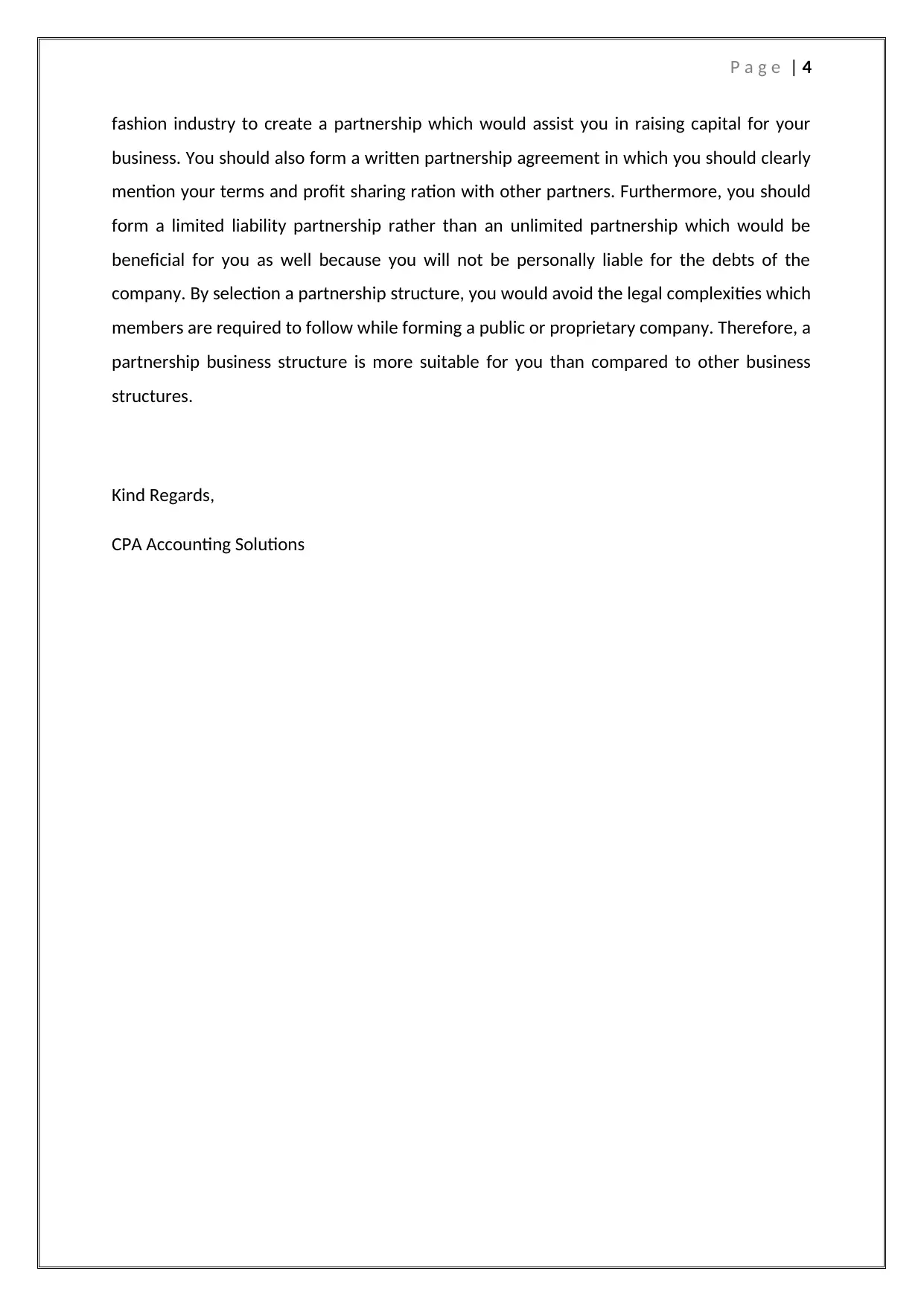
P a g e | 4
fashion industry to create a partnership which would assist you in raising capital for your
business. You should also form a written partnership agreement in which you should clearly
mention your terms and profit sharing ration with other partners. Furthermore, you should
form a limited liability partnership rather than an unlimited partnership which would be
beneficial for you as well because you will not be personally liable for the debts of the
company. By selection a partnership structure, you would avoid the legal complexities which
members are required to follow while forming a public or proprietary company. Therefore, a
partnership business structure is more suitable for you than compared to other business
structures.
Kind Regards,
CPA Accounting Solutions
fashion industry to create a partnership which would assist you in raising capital for your
business. You should also form a written partnership agreement in which you should clearly
mention your terms and profit sharing ration with other partners. Furthermore, you should
form a limited liability partnership rather than an unlimited partnership which would be
beneficial for you as well because you will not be personally liable for the debts of the
company. By selection a partnership structure, you would avoid the legal complexities which
members are required to follow while forming a public or proprietary company. Therefore, a
partnership business structure is more suitable for you than compared to other business
structures.
Kind Regards,
CPA Accounting Solutions
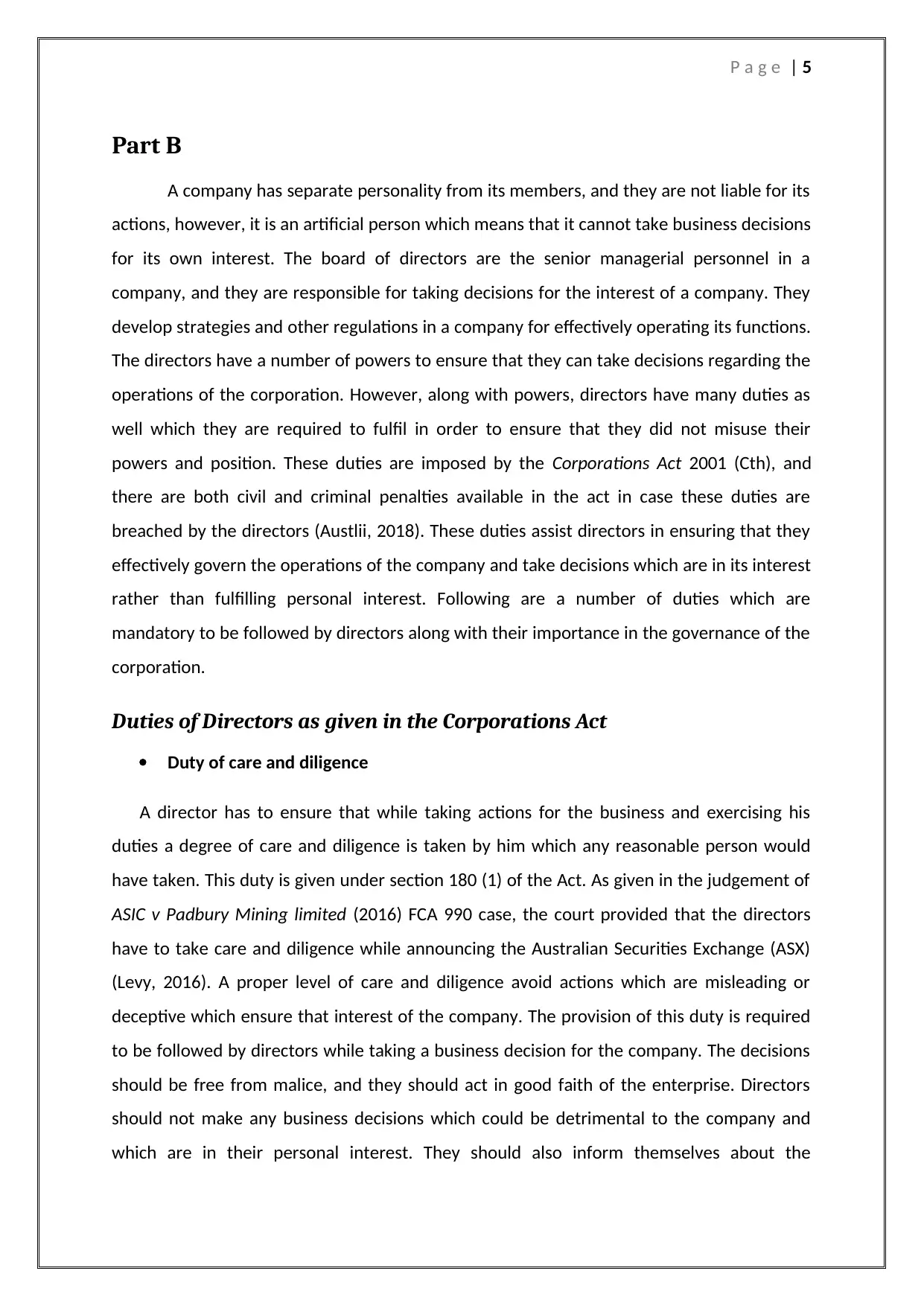
P a g e | 5
Part B
A company has separate personality from its members, and they are not liable for its
actions, however, it is an artificial person which means that it cannot take business decisions
for its own interest. The board of directors are the senior managerial personnel in a
company, and they are responsible for taking decisions for the interest of a company. They
develop strategies and other regulations in a company for effectively operating its functions.
The directors have a number of powers to ensure that they can take decisions regarding the
operations of the corporation. However, along with powers, directors have many duties as
well which they are required to fulfil in order to ensure that they did not misuse their
powers and position. These duties are imposed by the Corporations Act 2001 (Cth), and
there are both civil and criminal penalties available in the act in case these duties are
breached by the directors (Austlii, 2018). These duties assist directors in ensuring that they
effectively govern the operations of the company and take decisions which are in its interest
rather than fulfilling personal interest. Following are a number of duties which are
mandatory to be followed by directors along with their importance in the governance of the
corporation.
Duties of Directors as given in the Corporations Act
Duty of care and diligence
A director has to ensure that while taking actions for the business and exercising his
duties a degree of care and diligence is taken by him which any reasonable person would
have taken. This duty is given under section 180 (1) of the Act. As given in the judgement of
ASIC v Padbury Mining limited (2016) FCA 990 case, the court provided that the directors
have to take care and diligence while announcing the Australian Securities Exchange (ASX)
(Levy, 2016). A proper level of care and diligence avoid actions which are misleading or
deceptive which ensure that interest of the company. The provision of this duty is required
to be followed by directors while taking a business decision for the company. The decisions
should be free from malice, and they should act in good faith of the enterprise. Directors
should not make any business decisions which could be detrimental to the company and
which are in their personal interest. They should also inform themselves about the
Part B
A company has separate personality from its members, and they are not liable for its
actions, however, it is an artificial person which means that it cannot take business decisions
for its own interest. The board of directors are the senior managerial personnel in a
company, and they are responsible for taking decisions for the interest of a company. They
develop strategies and other regulations in a company for effectively operating its functions.
The directors have a number of powers to ensure that they can take decisions regarding the
operations of the corporation. However, along with powers, directors have many duties as
well which they are required to fulfil in order to ensure that they did not misuse their
powers and position. These duties are imposed by the Corporations Act 2001 (Cth), and
there are both civil and criminal penalties available in the act in case these duties are
breached by the directors (Austlii, 2018). These duties assist directors in ensuring that they
effectively govern the operations of the company and take decisions which are in its interest
rather than fulfilling personal interest. Following are a number of duties which are
mandatory to be followed by directors along with their importance in the governance of the
corporation.
Duties of Directors as given in the Corporations Act
Duty of care and diligence
A director has to ensure that while taking actions for the business and exercising his
duties a degree of care and diligence is taken by him which any reasonable person would
have taken. This duty is given under section 180 (1) of the Act. As given in the judgement of
ASIC v Padbury Mining limited (2016) FCA 990 case, the court provided that the directors
have to take care and diligence while announcing the Australian Securities Exchange (ASX)
(Levy, 2016). A proper level of care and diligence avoid actions which are misleading or
deceptive which ensure that interest of the company. The provision of this duty is required
to be followed by directors while taking a business decision for the company. The decisions
should be free from malice, and they should act in good faith of the enterprise. Directors
should not make any business decisions which could be detrimental to the company and
which are in their personal interest. They should also inform themselves about the
⊘ This is a preview!⊘
Do you want full access?
Subscribe today to unlock all pages.

Trusted by 1+ million students worldwide
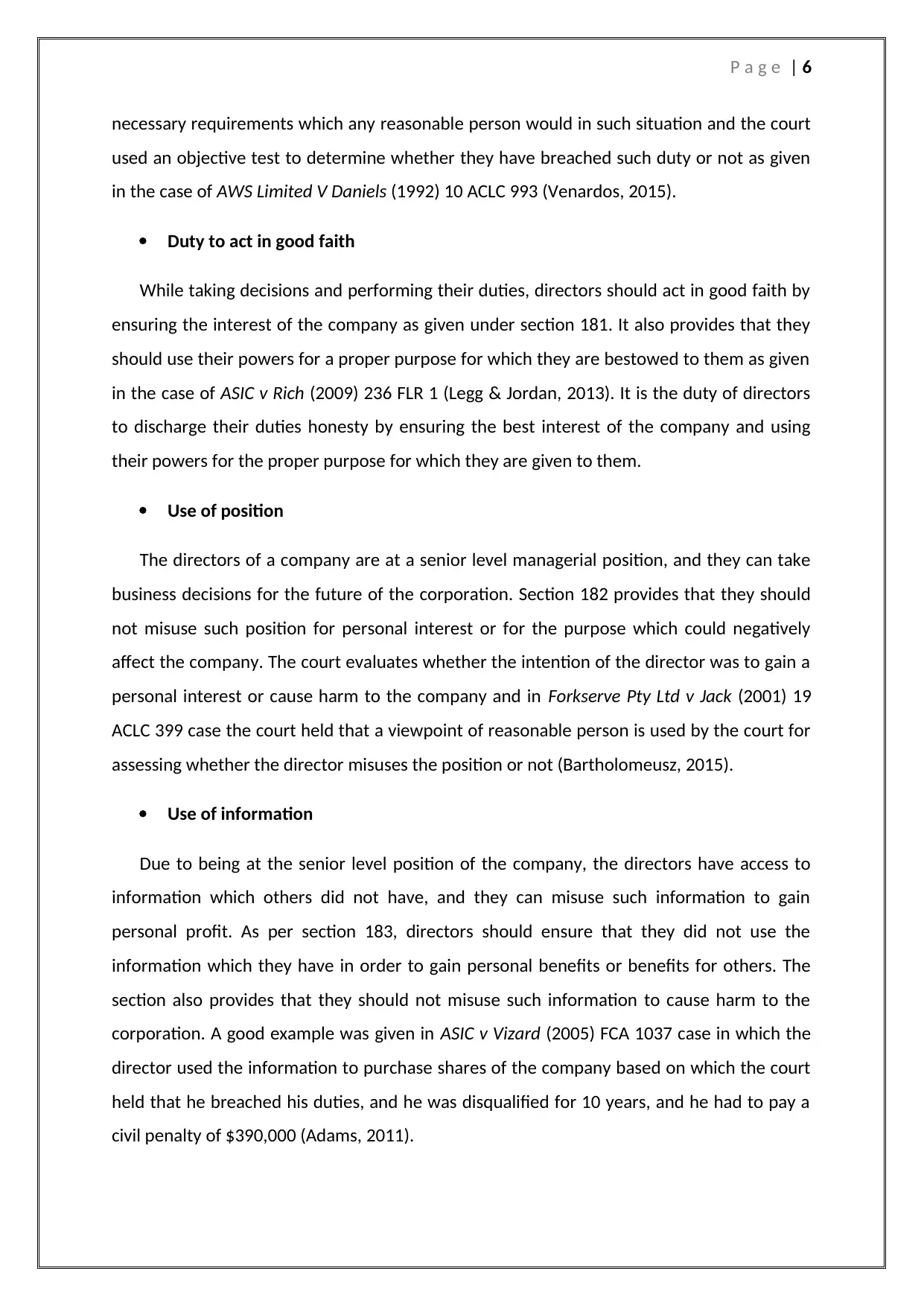
P a g e | 6
necessary requirements which any reasonable person would in such situation and the court
used an objective test to determine whether they have breached such duty or not as given
in the case of AWS Limited V Daniels (1992) 10 ACLC 993 (Venardos, 2015).
Duty to act in good faith
While taking decisions and performing their duties, directors should act in good faith by
ensuring the interest of the company as given under section 181. It also provides that they
should use their powers for a proper purpose for which they are bestowed to them as given
in the case of ASIC v Rich (2009) 236 FLR 1 (Legg & Jordan, 2013). It is the duty of directors
to discharge their duties honesty by ensuring the best interest of the company and using
their powers for the proper purpose for which they are given to them.
Use of position
The directors of a company are at a senior level managerial position, and they can take
business decisions for the future of the corporation. Section 182 provides that they should
not misuse such position for personal interest or for the purpose which could negatively
affect the company. The court evaluates whether the intention of the director was to gain a
personal interest or cause harm to the company and in Forkserve Pty Ltd v Jack (2001) 19
ACLC 399 case the court held that a viewpoint of reasonable person is used by the court for
assessing whether the director misuses the position or not (Bartholomeusz, 2015).
Use of information
Due to being at the senior level position of the company, the directors have access to
information which others did not have, and they can misuse such information to gain
personal profit. As per section 183, directors should ensure that they did not use the
information which they have in order to gain personal benefits or benefits for others. The
section also provides that they should not misuse such information to cause harm to the
corporation. A good example was given in ASIC v Vizard (2005) FCA 1037 case in which the
director used the information to purchase shares of the company based on which the court
held that he breached his duties, and he was disqualified for 10 years, and he had to pay a
civil penalty of $390,000 (Adams, 2011).
necessary requirements which any reasonable person would in such situation and the court
used an objective test to determine whether they have breached such duty or not as given
in the case of AWS Limited V Daniels (1992) 10 ACLC 993 (Venardos, 2015).
Duty to act in good faith
While taking decisions and performing their duties, directors should act in good faith by
ensuring the interest of the company as given under section 181. It also provides that they
should use their powers for a proper purpose for which they are bestowed to them as given
in the case of ASIC v Rich (2009) 236 FLR 1 (Legg & Jordan, 2013). It is the duty of directors
to discharge their duties honesty by ensuring the best interest of the company and using
their powers for the proper purpose for which they are given to them.
Use of position
The directors of a company are at a senior level managerial position, and they can take
business decisions for the future of the corporation. Section 182 provides that they should
not misuse such position for personal interest or for the purpose which could negatively
affect the company. The court evaluates whether the intention of the director was to gain a
personal interest or cause harm to the company and in Forkserve Pty Ltd v Jack (2001) 19
ACLC 399 case the court held that a viewpoint of reasonable person is used by the court for
assessing whether the director misuses the position or not (Bartholomeusz, 2015).
Use of information
Due to being at the senior level position of the company, the directors have access to
information which others did not have, and they can misuse such information to gain
personal profit. As per section 183, directors should ensure that they did not use the
information which they have in order to gain personal benefits or benefits for others. The
section also provides that they should not misuse such information to cause harm to the
corporation. A good example was given in ASIC v Vizard (2005) FCA 1037 case in which the
director used the information to purchase shares of the company based on which the court
held that he breached his duties, and he was disqualified for 10 years, and he had to pay a
civil penalty of $390,000 (Adams, 2011).
Paraphrase This Document
Need a fresh take? Get an instant paraphrase of this document with our AI Paraphraser
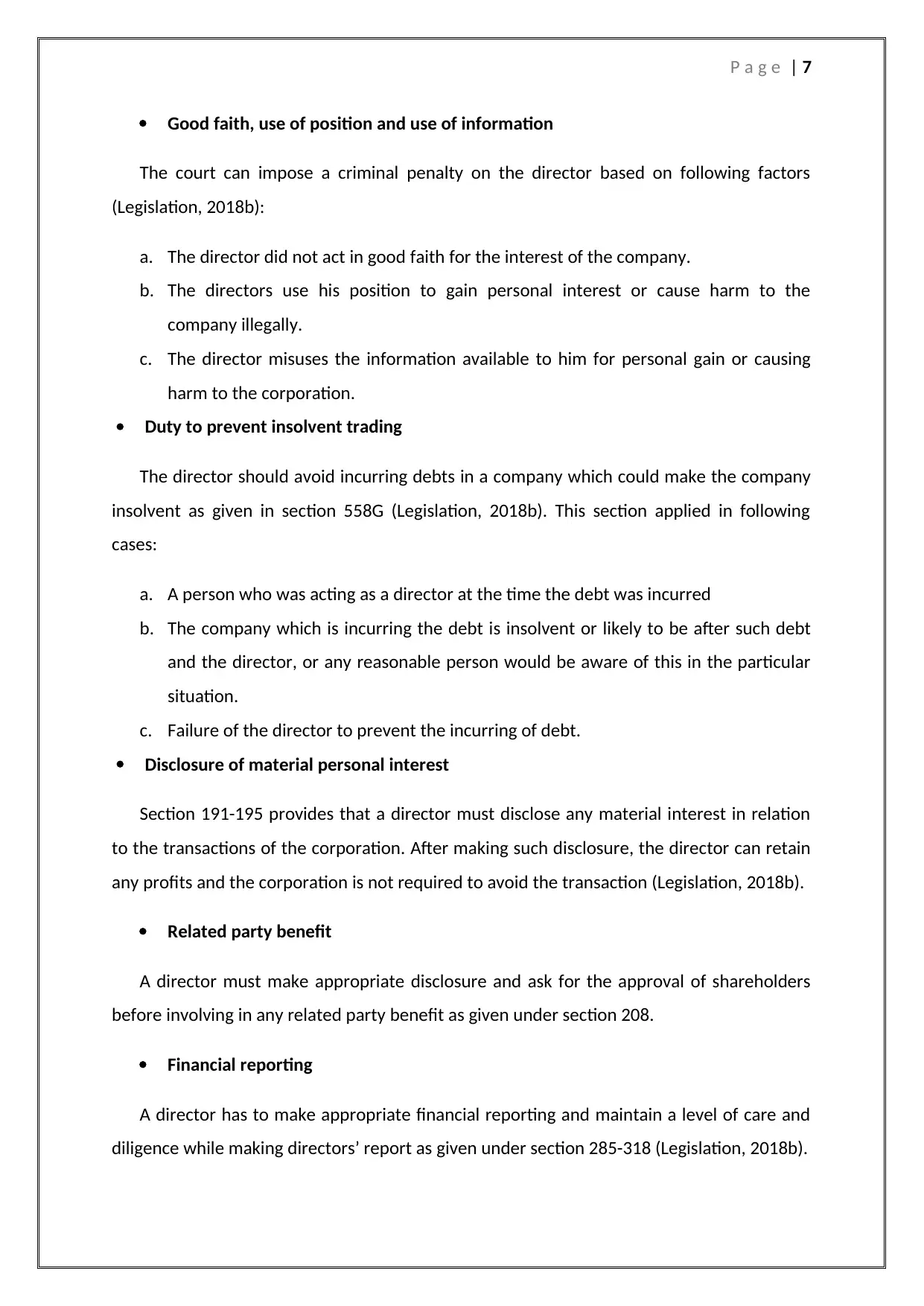
P a g e | 7
Good faith, use of position and use of information
The court can impose a criminal penalty on the director based on following factors
(Legislation, 2018b):
a. The director did not act in good faith for the interest of the company.
b. The directors use his position to gain personal interest or cause harm to the
company illegally.
c. The director misuses the information available to him for personal gain or causing
harm to the corporation.
Duty to prevent insolvent trading
The director should avoid incurring debts in a company which could make the company
insolvent as given in section 558G (Legislation, 2018b). This section applied in following
cases:
a. A person who was acting as a director at the time the debt was incurred
b. The company which is incurring the debt is insolvent or likely to be after such debt
and the director, or any reasonable person would be aware of this in the particular
situation.
c. Failure of the director to prevent the incurring of debt.
Disclosure of material personal interest
Section 191-195 provides that a director must disclose any material interest in relation
to the transactions of the corporation. After making such disclosure, the director can retain
any profits and the corporation is not required to avoid the transaction (Legislation, 2018b).
Related party benefit
A director must make appropriate disclosure and ask for the approval of shareholders
before involving in any related party benefit as given under section 208.
Financial reporting
A director has to make appropriate financial reporting and maintain a level of care and
diligence while making directors’ report as given under section 285-318 (Legislation, 2018b).
Good faith, use of position and use of information
The court can impose a criminal penalty on the director based on following factors
(Legislation, 2018b):
a. The director did not act in good faith for the interest of the company.
b. The directors use his position to gain personal interest or cause harm to the
company illegally.
c. The director misuses the information available to him for personal gain or causing
harm to the corporation.
Duty to prevent insolvent trading
The director should avoid incurring debts in a company which could make the company
insolvent as given in section 558G (Legislation, 2018b). This section applied in following
cases:
a. A person who was acting as a director at the time the debt was incurred
b. The company which is incurring the debt is insolvent or likely to be after such debt
and the director, or any reasonable person would be aware of this in the particular
situation.
c. Failure of the director to prevent the incurring of debt.
Disclosure of material personal interest
Section 191-195 provides that a director must disclose any material interest in relation
to the transactions of the corporation. After making such disclosure, the director can retain
any profits and the corporation is not required to avoid the transaction (Legislation, 2018b).
Related party benefit
A director must make appropriate disclosure and ask for the approval of shareholders
before involving in any related party benefit as given under section 208.
Financial reporting
A director has to make appropriate financial reporting and maintain a level of care and
diligence while making directors’ report as given under section 285-318 (Legislation, 2018b).
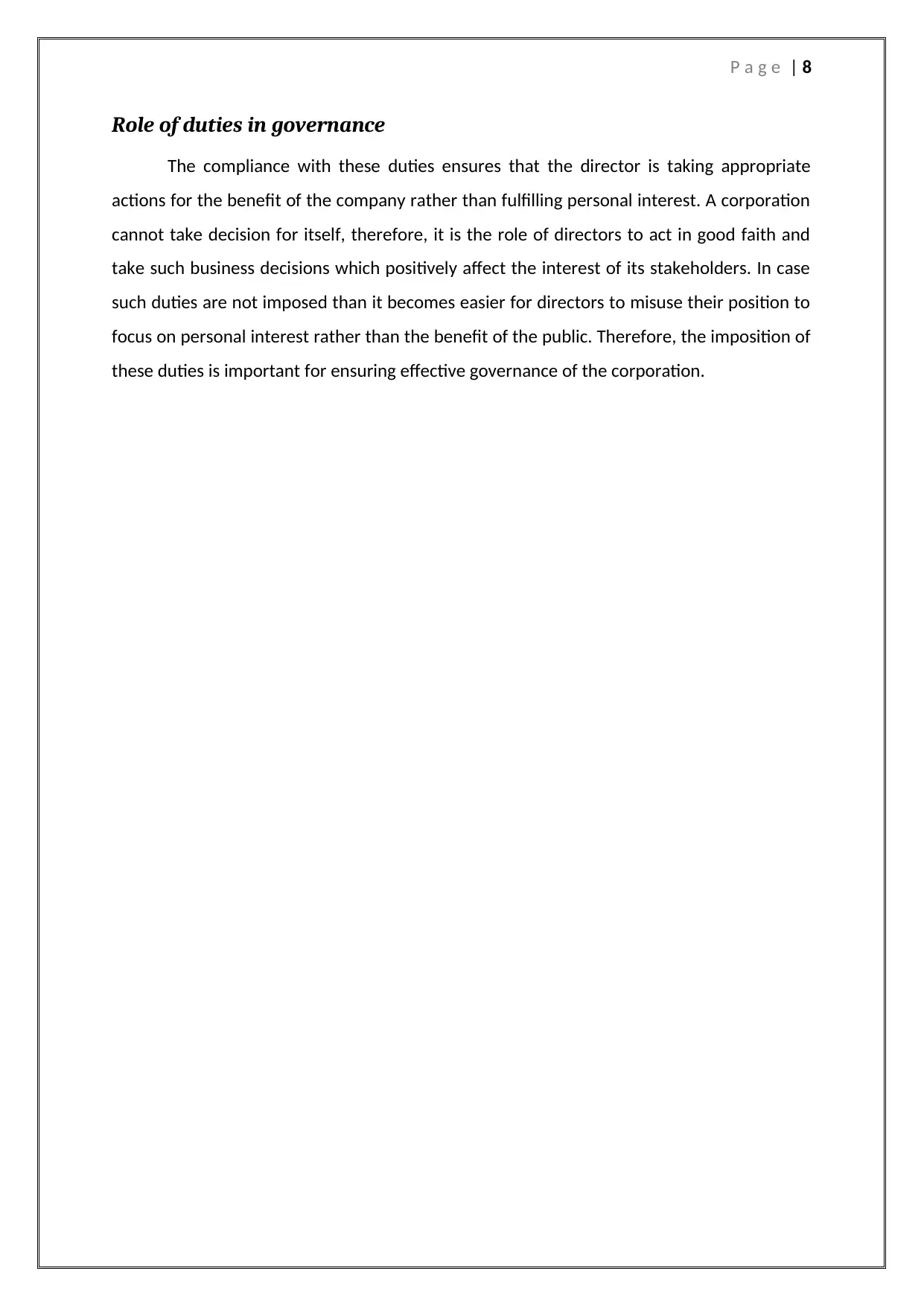
P a g e | 8
Role of duties in governance
The compliance with these duties ensures that the director is taking appropriate
actions for the benefit of the company rather than fulfilling personal interest. A corporation
cannot take decision for itself, therefore, it is the role of directors to act in good faith and
take such business decisions which positively affect the interest of its stakeholders. In case
such duties are not imposed than it becomes easier for directors to misuse their position to
focus on personal interest rather than the benefit of the public. Therefore, the imposition of
these duties is important for ensuring effective governance of the corporation.
Role of duties in governance
The compliance with these duties ensures that the director is taking appropriate
actions for the benefit of the company rather than fulfilling personal interest. A corporation
cannot take decision for itself, therefore, it is the role of directors to act in good faith and
take such business decisions which positively affect the interest of its stakeholders. In case
such duties are not imposed than it becomes easier for directors to misuse their position to
focus on personal interest rather than the benefit of the public. Therefore, the imposition of
these duties is important for ensuring effective governance of the corporation.
⊘ This is a preview!⊘
Do you want full access?
Subscribe today to unlock all pages.

Trusted by 1+ million students worldwide

P a g e | 9
References
Adams, M. (2011). Latest developments in officers’ duties of SMEs. Journal of Business
Systems, Governance and Ethics, 6(3), 31.
ASIC v Padbury Mining limited (2016) FCA 990
ASIC v Rich (2009) 236 FLR 1
ASIC v Vizard (2005) FCA 1037
ASIC. (2018). Your business structure. Retrieved from https://asic.gov.au/for-business/your-
business/your-business-structure/
Austlii. (2018). Corporations Act 2001 (Cth). Retrieved from http://www8.austlii.edu.au/cgi-
bin/viewdb/au/legis/cth/consol_act/ca2001172/
AWS Limited V Daniels (1992) 10 ACLC 993
Bartholomeusz, S. (2015). Directors’ Duties in Focus – Improper Use of Position. Retrieved
from https://youlegal.com.au/directors-duties-focus-improper-use-position/
Business.gov.au. (2017). Trust. Retrieved from https://www.business.gov.au/Info/Plan-and-
Start/Start-your-business/Business-structure/Business-structures-and-types/Trust
Business.gov.au. (2017a). Business Structures and Types. Retrieved from
https://www.business.gov.au/info/plan-and-start/start-your-business/business-
structure/business-structures-and-types
Corporations Act 2001 (Cth)
Duncan, W.D. (2012). Joint ventures law in Australia. Annandale: Federation Press.
Forkserve Pty Ltd v Jack (2001) 19 ACLC 399
Foss v Harbottle (1843) 67 ER 189
Idensohn, K. (2012). The fate of Foss under the Companies Act 71 of 2008: analyses. SA
Mercantile Law Journal= SA, 24(3), 355-360.
References
Adams, M. (2011). Latest developments in officers’ duties of SMEs. Journal of Business
Systems, Governance and Ethics, 6(3), 31.
ASIC v Padbury Mining limited (2016) FCA 990
ASIC v Rich (2009) 236 FLR 1
ASIC v Vizard (2005) FCA 1037
ASIC. (2018). Your business structure. Retrieved from https://asic.gov.au/for-business/your-
business/your-business-structure/
Austlii. (2018). Corporations Act 2001 (Cth). Retrieved from http://www8.austlii.edu.au/cgi-
bin/viewdb/au/legis/cth/consol_act/ca2001172/
AWS Limited V Daniels (1992) 10 ACLC 993
Bartholomeusz, S. (2015). Directors’ Duties in Focus – Improper Use of Position. Retrieved
from https://youlegal.com.au/directors-duties-focus-improper-use-position/
Business.gov.au. (2017). Trust. Retrieved from https://www.business.gov.au/Info/Plan-and-
Start/Start-your-business/Business-structure/Business-structures-and-types/Trust
Business.gov.au. (2017a). Business Structures and Types. Retrieved from
https://www.business.gov.au/info/plan-and-start/start-your-business/business-
structure/business-structures-and-types
Corporations Act 2001 (Cth)
Duncan, W.D. (2012). Joint ventures law in Australia. Annandale: Federation Press.
Forkserve Pty Ltd v Jack (2001) 19 ACLC 399
Foss v Harbottle (1843) 67 ER 189
Idensohn, K. (2012). The fate of Foss under the Companies Act 71 of 2008: analyses. SA
Mercantile Law Journal= SA, 24(3), 355-360.
Paraphrase This Document
Need a fresh take? Get an instant paraphrase of this document with our AI Paraphraser
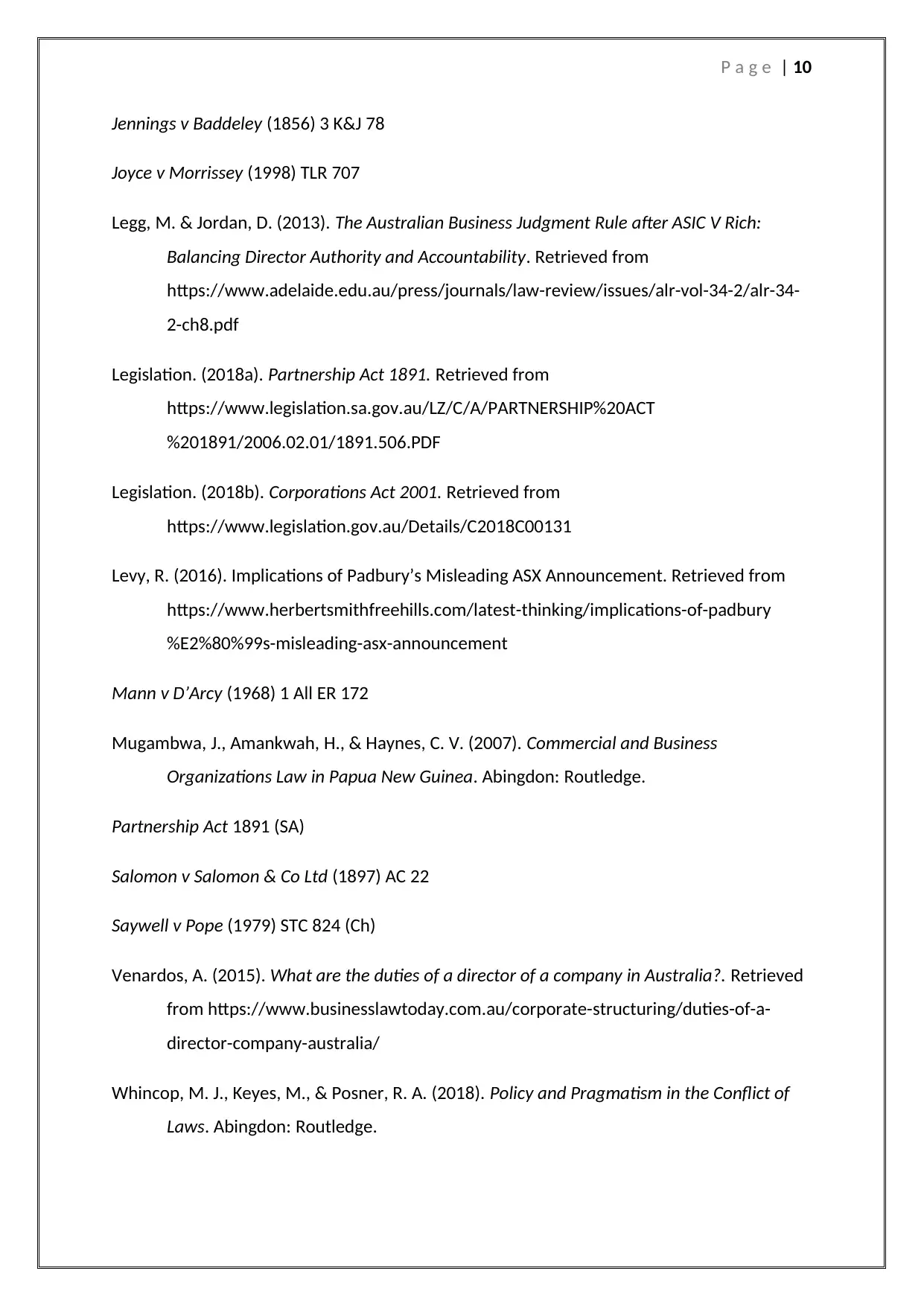
P a g e | 10
Jennings v Baddeley (1856) 3 K&J 78
Joyce v Morrissey (1998) TLR 707
Legg, M. & Jordan, D. (2013). The Australian Business Judgment Rule after ASIC V Rich:
Balancing Director Authority and Accountability. Retrieved from
https://www.adelaide.edu.au/press/journals/law-review/issues/alr-vol-34-2/alr-34-
2-ch8.pdf
Legislation. (2018a). Partnership Act 1891. Retrieved from
https://www.legislation.sa.gov.au/LZ/C/A/PARTNERSHIP%20ACT
%201891/2006.02.01/1891.506.PDF
Legislation. (2018b). Corporations Act 2001. Retrieved from
https://www.legislation.gov.au/Details/C2018C00131
Levy, R. (2016). Implications of Padbury’s Misleading ASX Announcement. Retrieved from
https://www.herbertsmithfreehills.com/latest-thinking/implications-of-padbury
%E2%80%99s-misleading-asx-announcement
Mann v D’Arcy (1968) 1 All ER 172
Mugambwa, J., Amankwah, H., & Haynes, C. V. (2007). Commercial and Business
Organizations Law in Papua New Guinea. Abingdon: Routledge.
Partnership Act 1891 (SA)
Salomon v Salomon & Co Ltd (1897) AC 22
Saywell v Pope (1979) STC 824 (Ch)
Venardos, A. (2015). What are the duties of a director of a company in Australia?. Retrieved
from https://www.businesslawtoday.com.au/corporate-structuring/duties-of-a-
director-company-australia/
Whincop, M. J., Keyes, M., & Posner, R. A. (2018). Policy and Pragmatism in the Conflict of
Laws. Abingdon: Routledge.
Jennings v Baddeley (1856) 3 K&J 78
Joyce v Morrissey (1998) TLR 707
Legg, M. & Jordan, D. (2013). The Australian Business Judgment Rule after ASIC V Rich:
Balancing Director Authority and Accountability. Retrieved from
https://www.adelaide.edu.au/press/journals/law-review/issues/alr-vol-34-2/alr-34-
2-ch8.pdf
Legislation. (2018a). Partnership Act 1891. Retrieved from
https://www.legislation.sa.gov.au/LZ/C/A/PARTNERSHIP%20ACT
%201891/2006.02.01/1891.506.PDF
Legislation. (2018b). Corporations Act 2001. Retrieved from
https://www.legislation.gov.au/Details/C2018C00131
Levy, R. (2016). Implications of Padbury’s Misleading ASX Announcement. Retrieved from
https://www.herbertsmithfreehills.com/latest-thinking/implications-of-padbury
%E2%80%99s-misleading-asx-announcement
Mann v D’Arcy (1968) 1 All ER 172
Mugambwa, J., Amankwah, H., & Haynes, C. V. (2007). Commercial and Business
Organizations Law in Papua New Guinea. Abingdon: Routledge.
Partnership Act 1891 (SA)
Salomon v Salomon & Co Ltd (1897) AC 22
Saywell v Pope (1979) STC 824 (Ch)
Venardos, A. (2015). What are the duties of a director of a company in Australia?. Retrieved
from https://www.businesslawtoday.com.au/corporate-structuring/duties-of-a-
director-company-australia/
Whincop, M. J., Keyes, M., & Posner, R. A. (2018). Policy and Pragmatism in the Conflict of
Laws. Abingdon: Routledge.
1 out of 11
Related Documents
Your All-in-One AI-Powered Toolkit for Academic Success.
+13062052269
info@desklib.com
Available 24*7 on WhatsApp / Email
![[object Object]](/_next/static/media/star-bottom.7253800d.svg)
Unlock your academic potential
Copyright © 2020–2025 A2Z Services. All Rights Reserved. Developed and managed by ZUCOL.



